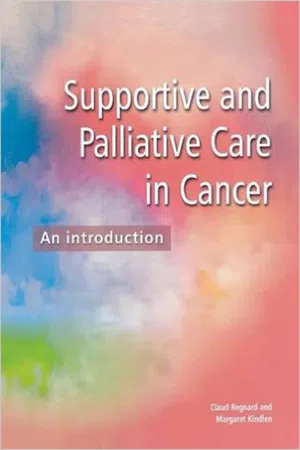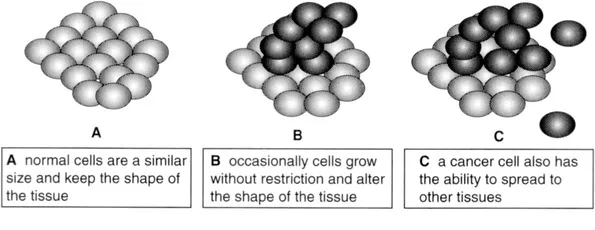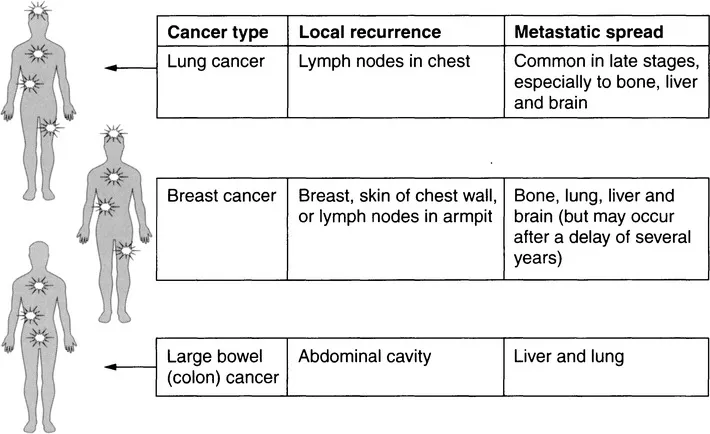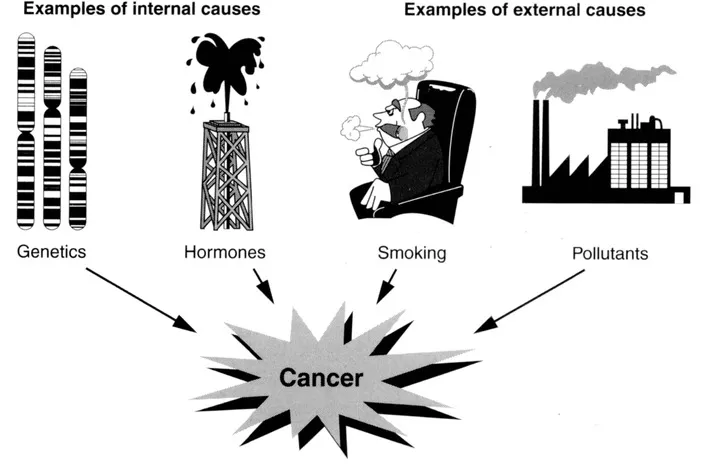
eBook - ePub
Supportive and Palliative Care in Cancer
An Introduction
This is a test
- 160 pages
- English
- ePUB (mobile friendly)
- Available on iOS & Android
eBook - ePub
Book details
Book preview
Table of contents
Citations
About This Book
This book provides a clear approach to establishing a user involvement system in a healthcare organisation and its potential impact on cancer services. Using a tool kit style approach drawing on examples of successful past projects and case studies to provide evidence of good practice it describes how to plan and implement different stages of user involvement enabling organisations to draw on user experience and expertise to evaluate develop and improve the quality of service that they provide. Members of regional cancer networks multidisciplinary cancer care teams and all those involved in the NHS cancer services will find this toolkit interesting reading.
Frequently asked questions
At the moment all of our mobile-responsive ePub books are available to download via the app. Most of our PDFs are also available to download and we're working on making the final remaining ones downloadable now. Learn more here.
Both plans give you full access to the library and all of Perlego’s features. The only differences are the price and subscription period: With the annual plan you’ll save around 30% compared to 12 months on the monthly plan.
We are an online textbook subscription service, where you can get access to an entire online library for less than the price of a single book per month. With over 1 million books across 1000+ topics, we’ve got you covered! Learn more here.
Look out for the read-aloud symbol on your next book to see if you can listen to it. The read-aloud tool reads text aloud for you, highlighting the text as it is being read. You can pause it, speed it up and slow it down. Learn more here.
Yes, you can access Supportive and Palliative Care in Cancer by Claud F B Regnard, Margaret Kindlen in PDF and/or ePUB format, as well as other popular books in Medicine & Medical Theory, Practice & Reference. We have over one million books available in our catalogue for you to explore.
Information
Section 1
Cancer
- What is cancer?
- What causes cancer?
- Types of cancer
- Detecting cancer
- Cancer diagnosis and monitoring
What is cancer?
What should I know?
Cancer is a group of diseases. Cancers can arise from any of the normal tissues in the body, therefore there can be many different types of cancer. The two hallmarks of cancers are their ability for uncontrolled growth and their potential to invade other tissues.
How common is cancer?
Forty percent (2 in 5) of the population will be affected by cancer. Some cancers are much more common than other cancers.
How serious is a diagnosis of cancer?
Twenty-five percent (1 in 4) of the population will die from cancer. Many cancers can be cured, especially if diagnosed at an early stage. Other cancers present late or are resistant to treatment.
Uncontrolled growth
The ability of cells to grow and reproduce is normally tightly controlled to ensure the body maintains its correct shape and function. Occasionally a cell will grow and duplicate itself with little control. If it stays as a local lump this is called a benign tumour. It only becomes a cancer if it has the potential to spread.
The potential for spread
Unlike other cells, cancer cells can spread from their original site (the ‘primary tumour’) by invading local tissues or spreading to distant sites (‘secondary tumours’ or ‘metastases’).

Treatment and progress of cancer
Cancer treatment can include surgery, radiotherapy or chemotherapy, or a combination of these to eradicate cancer cells.
Following treatment some tumour cells may survive and subsequently cause problems for patients through local recurrence or metastatic spread.
Local recurrence
The microscopic cells that are not killed by original treatment continue to grow at the original primary site and eventually give rise to symptoms. Most recurrences appear within 1–2 years after initial treatment, although sometimes it takes many years before they appear.
Metastatic spread
Cancer cells spread in two ways.
- Local spread: a cancer can invade nearby tissues causing damage or distortion of those tissues.
- Distant spread: cells can break off from the primary tumour to form satellite sites. This process is called ‘metastatic spread’. The cancer cells can spread through lymph or blood vessels. Common sites of metastases include lymph nodes, bone, lungs and liver.
The pattern of spread varies between different cancers.
How can I use this information?
Knowing the typical pattern of spread of a cancer indicates where to look for signs of local or distant spread (see Table below).

Key points
- Cancer can arise from any normal tissue in the body.
- The two hallmarks of cancer are uncontrolled growth, and the ability of the original site (the primary tumour) to spread to other tissues.
- Spread of cancer can be by the invasion of nearby tissues, and by spreading to distant tissues through the blood or lymphatic system (metastatic spread) to form secondary tumours or metastases.
- Different cancers have different patterns of spread.
What causes cancer?
What should I know?
There is no single cause of cancer but there are many factors that combine to increase the risk. There are two types of factor – those that are within the individual and others that are external. For many people, cancer will only develop if several factors are present.

Internal factors
Genetics: we inherit our characteristics through our genes passed on from our parents. For most people there is no obvious hereditary cause of cancer. However, we now know that many people with cancer have a basic change in the cell genes which control normal growth. It is this fault which leads to the development of cancer. Cancer is inherited in a few people, but this type of inheritance is rare, e.g. less than 5% of all breast cancer cases originate from detectable genetic abnormalities.
Hormones: although hormones can affect the growth of cancer, very few cancers are caused by natural hormones (cancer of the uterus is one such type). Some cancers are sensitive to changes in hormones and this sensitivity is used in the treatment of breast and prostate cancers.
External factors
Exposure to environmental factors over a period of time can cause cancer. Tobacco tars are the biggest cause of cancer, but many chemicals, viruses and physical agents (e.g. ultraviolet light in sunlight) can have a similar effect. This has implications for work-related cancers resulting from exposure to asbestos, soot, some metals, radiation or sunlight.
Each of these agents has a particular association with a particular type of cancer, e.g. tobacco with lung cancer, oesophageal and bladder cancer; and ultraviolet light/sunlight with skin cancer.
However, it is important to realise that there are often several causes. Several of these factors are needed together to affect the way some cells grow and reproduce.
How can I use this information?
Knowing what factors might increase the risk of cancer will help you recognise how certain lifestyles and work histories are important.
Industry and organisations where there are potential hazards relating to materials being used are subject to health and safety standards and are required to monitor the health of the workforce.
Family doctors when aware of family history of a specific cancer will be on the alert and channel people into screening programmes.
Key points
- There is no single cause of cancer.
- A combination of genetic faults and exposure to external agents ...
Table of contents
- Cover
- Title Page
- Copyright Page
- Contents
- About the authors
- Introduction
- Acknowledgements
- Section 1: Cancer
- Section 2: Cancer treatments
- Section 3: Supportive and palliative care
- Section 4: Cancer pain
- Section 5: Symptoms
- Section 6: Communication
- Section 7: Dying and bereavement
- Section 8: Spirituality and equality
- Glossary
- Index